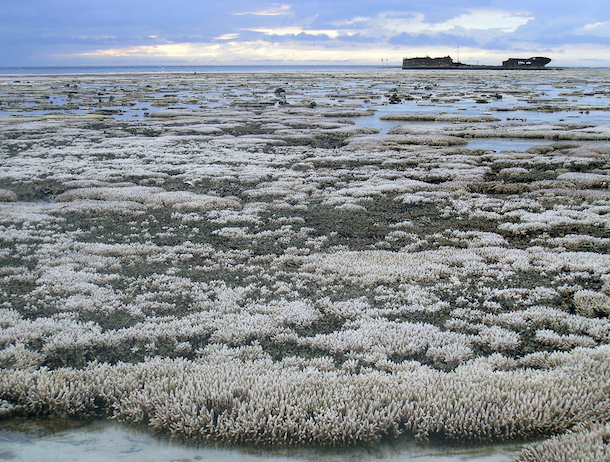
Coral Adaptation Won’t Save Reefs in Time to Prevent Humanitarian Disaster
Amid dire reports of unprecedented coral reef loss due to rising sea temperatures, there may yet be cause for optimism with respect to the long-term survival of reef ecosystems.
Early evidence of certain coral species’ ability to adapt to—and even thrive in—warming seas suggest that climate change will not necessarily bring about the end of coral reefs altogether, although it will likely result in the end of coral reefs as we’ve known them. During the decades that it will take for reefs to repopulate with heat-resistant coral species, ecosystem collapse is all but a foregone conclusion. The destruction of reef ecosystems, even if it is temporary, is likely to result in permanent biodiversity loss; one-quarter of all marine species currently live in and around coral reefs.
The United Nations Environment Program projects that the loss of coral reefs will endanger 275 million people worldwide who rely directly on these ecosystems for their livelihoods. A further 850 million people who rely indirectly on coral reefs will be negatively affected as sea temperatures continue to rise. Without proper preparation, the rapid loss of reefs could easily result in humanitarian crises affecting hundreds of millions of people worldwide.
Coral reefs occupy less than 1% of the ocean floor, concentrating an astounding array of marine life into relatively small areas. Like the various species that live among coral, humans are drawn to reefs for their bounty; fishing, tourism, marine mining, and other reef-dependent industries generate an estimated $375 billion dollars each year. Reefs are also immensely valuable for the ecosystem services they provide, which include nurturing fish populations as well as protecting coastal areas by serving as storm barriers.
Beyond their direct economic value, coral reefs are venerated as treasures of the natural world—UNESCO recognizes a number of reef sites, including the Great Barrier Reef, the Belize Barrier Reef, Tubbataha Reef in the Philippines, the Lagoons of New Caledonia, and Colombia’s Malpelo Sanctuary among its list of Natural World Heritage Sites.
However, despite their protected status, coral reefs are nonetheless at risk as rising ocean temperatures contribute to increased rates of coral bleaching—a process in which environmental stress causes individual coral polyps to expel the algae that provide the majority of their energy. Sustained high water temperature lead to coral starvation and eventually death. Mass bleaching events that damage and kill entire reefs are projected to become increasingly common as global ocean warming trends continue.
Last year, approximately 29% of shallow-water corals in the northern portion of the Great Barrier reef died as the result of bleaching; 70% of coral in this part of the reef has now died due to rising sea temperatures, and the 30% that remains is likely to face even warmer temperatures in years to come.

Coral have managed to survive over 500 million years of gradually shifting planetary conditions. Whether they can now adapt to survive anthropogenic climate change remains to be seen. The answer to this question will depend, in no small part, on the extent to which human activity continues to contribute to a warming climate. For sensitive coral species, an average sea temperature change of just a fraction of a degree has already proven deadly. As the climate continues to change, the rate of change will largely determine how effectively coral and coral reef ecosystems are able to adapt.
In warming seas, natural selection will favor coral species which are better able to resist bleaching or which can recover from bleaching faster. For coral to survive and thrive, their symbiotic relationship with algae must adapt. Bleaching occurs when warm water triggers coral to expel algae as a means to reduce metabolic strain—without algae, coral appears white, hence the term “bleaching.” This short-term survival strategy is effective only in instances where sea temperatures quickly return to normal; if a coral structure remains stressed by heat for too long, it may not be recolonized by algae and will eventually starve.
Reef ecosystems are already beginning to adapt to a warmer climate. This process is slow—far slower than the rate at which sea temperatures are currently rising. Yet, scattered observations of resilient coral and reports of heat-tolerant algae are encouraging signs. Even if a majority of the world’s reefs do end up collapsing, small populations of the most adaptable coral species may well survive to repopulate the world’s oceans once global temperatures stabilize in the far future, perhaps decades from now. Of course, this is far from a best-case scenario; the loss of coral reefs will likely entail a devastating extinction event affecting many of the approximately 2 million marine species that currently live in and around coral reefs.
For humanity, the impending loss of coral reefs will have profound and immediate impacts. Bleaching events can kill entire reefs with little notice, creating unanticipated food shortages and depriving coastal communities of major sources of income. As with many of the effects of climate change, the death of global reefs will likely have the greatest negative impact on people in the developing world, where local welfare is more directly dependent on the extraction of reef-based resources. As reefs disappear, so will a wide array of reef-based economic activities, including small- and large-scale fishing, mineral extraction, tourism, and recreation. Just as they form the ecological foundation for reef ecosystems, coral also provides an economic foundation that supports hundreds of millions of people worldwide. The 275 million people who rely directly on coral reefs for their welfare will be forced to confront a growing dilemma in coming years as annual bleaching events continue to increase in scope and severity.
Without feasible, accessible alternatives, many of the most vulnerable coral-dependent communities could face simultaneous economic ruin and food shortages. The outlook for these communities becomes grimmer when other effects of climate change, including rising sea levels and increased incidence of extreme weather, are taken into consideration.
Human intervention that aims to seed vulnerable reefs with hardy species of coral may help to prevent total reef death in some instances, but such measures will not go far enough to prevent the short-term humanitarian crises that the wide-scale loss of coral ecosystems will bring about.
It seems unlikely that crises can be avoided altogether, given the wide gap between the rate at which coral is dying and the rate at which more resilient species are able to recolonize damaged reefs. Given this disparity, it is essential that vulnerable communities prepare for the worst, at least in the short term, by working with governments and aid organizations to secure reliable sources of food, medicine, and other basic goods. Economic loss is all but inevitable—fisheries have already begun to suffer as result of reef death, and more suffering is unlikely to be avoided—but with adequate planning, this burden can be minimized through timely and effectively-managed transitions to sustainable fishing, aquaculture, and other analogous economic activities.
Coral reefs will be among the first ecosystem-scale victims of climate change. While they may not disappear forever, adaptation and recolonization will take decades or centuries—and ecological stability will not be fully possible until global sea temperatures finally stabilize. If anything good can emerge from this regrettable chapter of our species’ natural history, perhaps it will be a much-needed sense of urgency with respect to our rapidly-changing climate and of responsibility towards those who stand to be most seriously affected.
